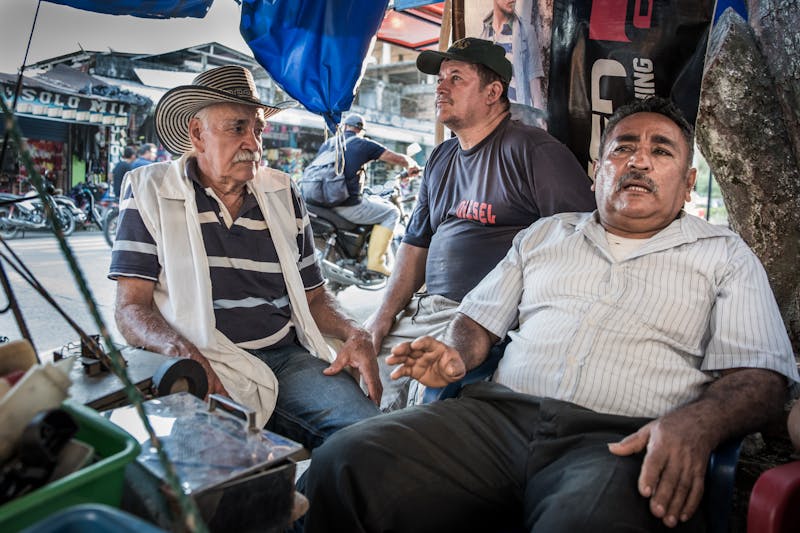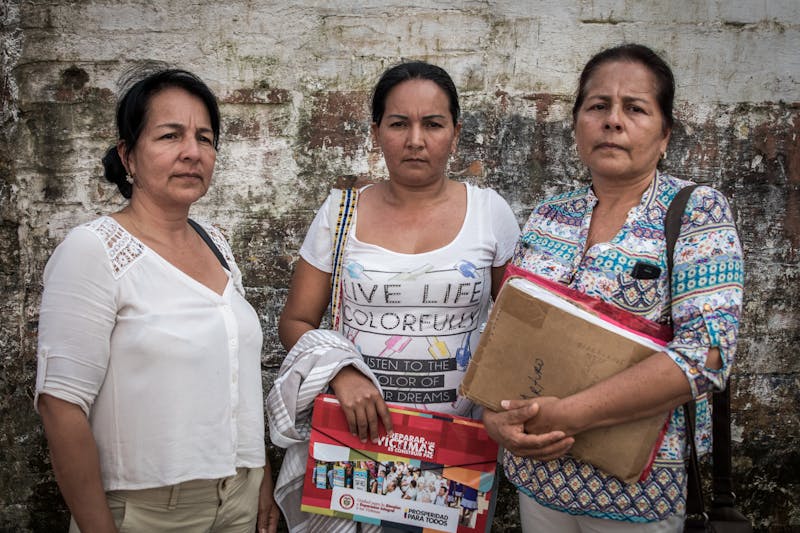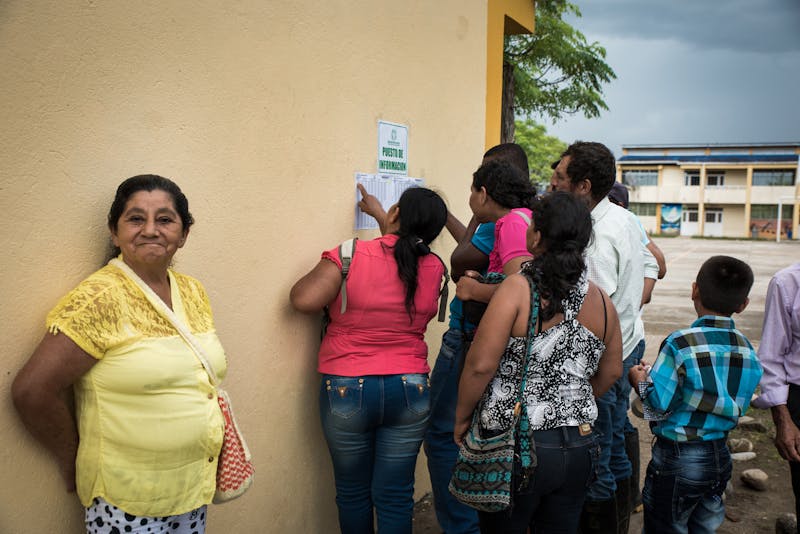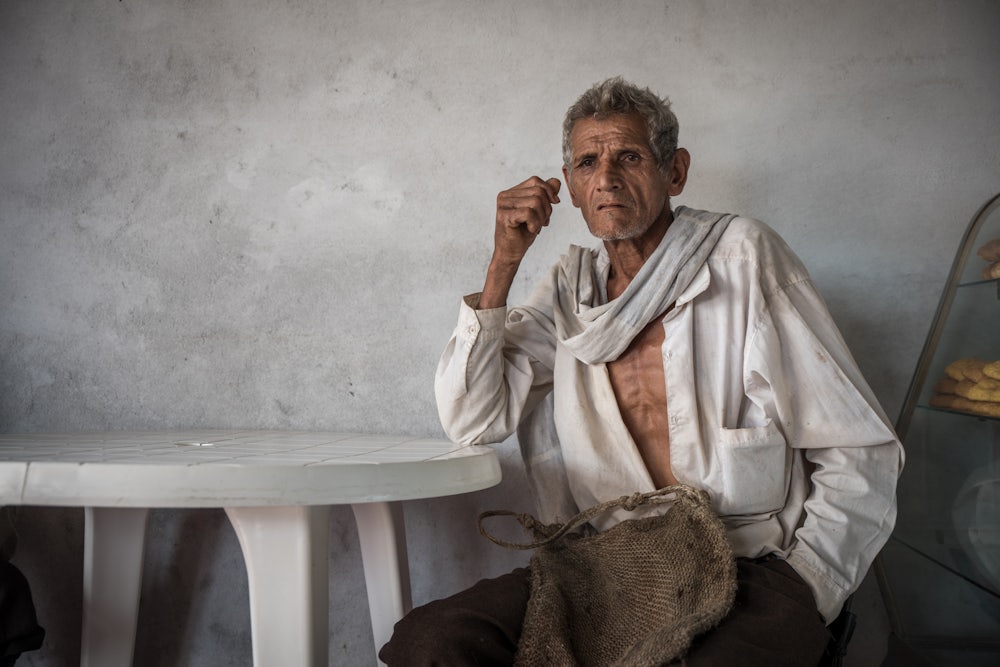On Sunday, Colombian voters shocked the world by voting against a peace agreement between the government and the Revolutionary Armed Forces of Colombia (FARC), an immense setback for the administration of President Juan Manuel Santos that left the country’s future in limbo. Santos said a cease-fire with the FARC would remain in place, and that he would “convene all political groups ... to open spaces for dialogue and determine how we will go ahead.” Whether the FARC will be open to an accord that demands more concessions remains an open question.
Hesmar Agudelo Granada has what you need, even if you don’t know you need it yet. Saws, herbs, pot handles, a dusty but lightly worn copy of The Modern Girl and Sex, by Dr. Juan F. Night. He sets up his cart on the same corner every morning, one block over from the main plaza in Puerto Asís, a boom town in Colombia’s southern coca-growing region, along the border with Ecuador. The merchandise varies, depending on availability, but if he doesn’t have what you’re looking for, he probably knows where to find it.
“I’ve always been a hard worker, an entrepreneur,” he says, “not like those shameless motherfuckers they signed that deal with in Cartagena.” Hesmar has nothing against the Revolutionary Armed Forces of Colombia (FARC) per se. For the most part, he got along with the guerrillas just fine, back when he used to park his old cart on the other side of the river, over by the FARC’s main camp in the area. He helped out people in the community, and in recognition, the rebels never charged him the vacuna payments they demanded from other vendors. “Good people,” he says of the rank-and-file guerrillas, former and current alike, who stop by every once in a while to pay their respects or shop. “They just follow orders.” It’s the commanders Hesmar has a problem with: “Those thieving bastards, all they do is stuff their pockets.”
In a previous life, Hesmar was a hardcore leftist himself. A member of a radical peasant organization and leftist workers’ party, he was one of the sole survivors of a 1983 massacre that left at least 20 people dead—“at least” because the paramilitaries who committed the massacre disappeared some of their victims and disposed of others, piece by piece, in the river. Hesmar shows off the scars on his back and clavicle where they tried to decapitate him with a machete. Years later, the paramilitaries killed his father and brother and stole their family farm, but Hesmar doesn’t dwell on it. “I’m not one for tears,” he says. “The past is in the past. All you can do is get on with it.”
When he first arrived in the Putumayo Department in the early 1990s, Hesmar could still appreciate what the FARC seemed to stand for. “The state didn’t exist here, so they were the ones who served that function,” he says. “They would meet with the communities to share their ideals. Who’s not going to agree with schools and roads and health care?” But then the rebels got deeper and deeper into the drug trade, then deeper and deeper into extortion. Their justice became harsher and less discerning. One afternoon, his wife’s teenage daughter brought a police officer to their house without Hesmar’s knowledge, and the rebels tied him to a tree for two weeks—only sparing his life after his friends came to beg for it. To punish an uncooperative businessman, the guerrillas set fire to his gas station, blowing up an entire neighborhood, along with Hesmar’s cart. Hesmar’s wife was pregnant at the time, and for a while, he wasn’t sure what he would do to sustain his family. “They pretend to be for the people, but it’s always the poor who end up suffering,” he says.

Hesmar knows that the Sí campaign is going to win—that’s what all the polls have been saying—but he’s going to vote to reject the historic peace accord between the FARC and the government of President Juan Manuel Santos, which seeks to bring an end to the oldest armed conflict in the Western Hemisphere. “They’ve prohibited us from campaigning for No here,” he says, looking around for cops. But Hesmar is also encouraging anyone who will listen to do the same. “I’ve always said things the way they are,” he explains.
People start to show up at the Victims’ Attention Center at four o’clock in the morning, long before the first stands around Puerto Asís’s main plaza start serving fruit juice and arepas. By seven, the line snakes a third of the way down the block. The doors to the waiting room haven’t even opened yet, and already, latecomers run the risk of being turned away on the spot. According to the national government, about 43 percent of Putumayo’s 350,000 inhabitants are victims of the Colombian armed conflict. The Putumayo office had no information on how many have tried to access government assistance measures, but those who have say the byzantine, overtaxed system is its own kind of protracted suffering.
Nubia Paz Tejada crossed the border from Ecuador to be here. On a map, the trip is short enough. But Nubia spent 24 hours and more money than she can afford traveling over unpaved roads and unbridged rivers to make her appointment. Her two sisters, Ruby and Berenice, both live in town now. All three of the Paz Tejada sisters have been forced to flee Peñas Coloradas, the isolated jungle vereda (a hamlet, roughly speaking) where they grew up in the Puerto Asís municipality. The FARC disappeared Nubia’s husband 15 years ago, and Ruby’s seven years after that. The guerrillas didn’t offer an explanation. At one point, Nubia and Ruby had convinced them to reveal the coordinates where the corpses were buried, but in the end, the guerrillas didn’t provide those, either. For submitting formal denunciations, the sisters and their children received death threats. Berenice, the youngest sister, was marked for death as well, when her son enlisted for mandatory military service.

“It’s so hard to start over in a new place with nothing,” says Nubia. “No friends, no family, no support.” At 33, she was suddenly a single mother of seven with limited professional skills and no work experience. She could have used government assistance then to secure suitable housing, and she could still use it now, with her children at or approaching university age. “I want them to have better opportunities, but how can I send them away to study if I can’t even cover rent for our house?”
Nubia didn’t come all this way to yell with a case officer over another measly check—though she’ll take that, too, if she can get it. She’s here to vote Sí in the plebiscite for the FARC peace accords. There’s a whole section covering victims’ rights. Nubia hasn’t read it, but on the TV they said it deals with reparations, both emotional and material. “We want the truth,” she says. “I want to bury my husband. I want to know why he died. How can people who haven’t felt what we’ve lived deny that?”
Elvia Solarte doesn’t trust any of them. Not the media, which “never show things the way they actually are.” Not the NGOs, which parachute in with their fancy experts and “keep the money for themselves.” Not the activists from the center of the country, who lecture her about peace but “don’t know what the violence has been.” Not the politicians, “shameless bastards” the lot, who steal from the poor and sell the country to the multinationals. Not the military, “the real human rights violators” in the Colombian armed conflict. And especially not the government, “barefaced corruption” incarnate.
It’s not that she’s a cynic. Elvia wants to believe that the FARC peace accord will be different. But a lifetime of abuse and neglect from the government tells her that it won’t. Elvia remembers in 2000, when they launched Plan Colombia, the U.S.-backed counterinsurgency and counter-narcotics campaign. They had made promises then, too, some of the same ones you hear on the TV now. Campesinos who pulled up their coca fields would be compensated and provided with viable alternatives. After ignoring who knows how many proposals, pleas, and demands from people like Elvia, the Colombian state was going to build the roads and schools and medical centers that communities like Piñuña Blanco deserved.
Those had been the worst years. First came the fumigations. Planes full of weaponized herbicide destroyed everything except the coca, which is used to make cocaine. Plantains, yucca, the fish in the bountiful rivers, the birds in the lush jungle canopy. Elvia still gets choked up thinking about the “poor little animals crying.” Next were the paramilitaries. They killed so many people; in public, in broad day, it didn’t matter. Elvia’s brother and first-born son were among the dead, and she would have been as well, except she convinced them not to kill her. (“Good boys,” she says of her captors now.) After that, she didn’t dare leave the village. Not until 2006, when the military kidnapped and imprisoned her husband, claiming he was a guerrilla. Then she had no choice but to try and free him.
Elvia scoffs at the idea that the FARC peace deal will affect the Colombian drug trade. “They can’t go after the real trafficking networks, because a lot of important people would fall,” she says. She hopes that maybe, with the all the slated social spending in the deal, she can get help rebuilding the Casa Campesina, the National Association of Peasant Unions (ANUC) headquarters that she manages in Puerto Asís; 300 people stayed there during a major flood in 2002, she points out, 150 during a firefight between the Army and the rebels two years back. She also wishes Putumayo had a public university where she could afford to send her five children, but she knows that won’t happen, either. “The money will get lost in the chain,” she says. Here, every contract, grant, and budget line item comes with a “CVY” markup included: Como Voy Yo (What About Me?). “Why submit a proposal if they’re just going to rob it all, anyway?”
The whole peace process, she says, is “a lie.” “They just want to kick us out of our territories so that they can have the resources.” She adds, “Trust me, a lot of people are sad” about the FARC demobilizing. “Who’s going to protect us now?” So does that mean she’s going to vote against the deal in Sunday’s plebiscite? “No, of course not. I’m going to vote Sí. What other option is there?”
For the Siona, the war for Putumayo started 500 years ago, not 50. They haven’t known peace since, only pauses in the fighting. Between the rubber and quinine booms at the turn of the 20th century, at least 40,000 indigenous people were lost to disease and slavery, according to the Center for Historic Memory. Then the settlers came to cut down the old-growth hardwood. Texaco discovered oil underneath the jungle in the early 60s. Two decades later, coca, the sacred bush their Andean sisters and brothers had been cultivating for millennia, took over the lowland plains like a plague, bringing death and destruction in place of healing. “An Indian without territory is an Indian without life,” says Governor Hubeimar López Payaguaje. The Siona have been losing both for decades.
In accordance with the Colombian Constitution, the 37 Siona families that make up this reserve have autonomous domain over the land they occupy, just outside the Puerto Asís city limits. That means that any development project falling within their purview must first undergo a special review process, culminating in approval by the community. In principle, this prior consultation mechanism is a powerful guarantee of indigenous rights. But for the Siona of Puerto Asís, as for many indigenous peoples across Colombia, the legal theory doesn’t account for the only authority that ultimately matters: that of the territory itself.
The rivers that pass through Siona territory have their sources up in the Andes mountains to the west. In between are miles and miles of some of the heaviest petroleum production in Colombia, as well as some of its densest coca farming. Both activities contaminate on a massive scale: coca farming because of its monoculture dependence on industrial pesticide, oil drilling because it’s oil drilling. In the long run, environmental degradation is the greatest threat to the Siona’s survival in Puerto Asís, and López doesn’t trust either party involved in the peace negotiations to resolve it for them.
“This is a conflict between the FARC and the government and a negotiation between the FARC and the government,” says López. “They should have created a broad table for everyone, because their problems have impacted all of us. But they can’t just agree to a policy between the two of them and expect us to go out and back it.” Lopez isn’t telling his people how to vote, or whether to vote at all, because he doesn’t think it will make much of a difference one way or the other. “Our fight has its own form and its own pace,” he says. “For now, we have to focus on recovering our customs, our traditions. And in that way, we can recover our territory.”
Aquileo Mosquera swaggers into the schoolhouse at 9 o’clock in the morning, all smiles, gladhanding down the line of election monitors and cracking jokes from the polling booth. Most of the people in Jardines de Sucumbíos, a small coca-growing community tucked against the immense green wall of the Andes mountains to the west, won’t be down to vote until just before afternoon Mass. So Aquileo chums it up long enough to make a respectable exit, then hops back on his motorcycle and speeds off, satisfied with a job well done.
For the past few days, he has been running back and forth across the far-flung Afro, Indigenous, and campesino settlements that together make up Sucumbíos, riling up the troops to show out in support of Sí. “The people are really confused,” he says. “Of course they haven’t read the accords. Who has? But what’s worrisome is that they’ve heard a lot of misinformation, from the TV or gossip, I don’t know.”

In other parts of the country, the talking points for No have been different. They’re going to raise taxes. They’re going to expropriate property. But the only thing that matters here is coca. People have been saying that if Sí wins, they’re going to come take the coca—which, Aquileo insists, they’re going to do either way. Not for the first time, and probably not for the last, it fell on him to go from community meeting to community meeting to explain to everyone what the deal is.
It’s taken the coca farmers of Putumayo 20 years to get to this point. They’ve marched on the highways and town plazas, through fumigations, bombings, beatings, and massacres, all for the comprehensive long-term alternative development plan Aquileo and other regional leaders have been hashing out with negotiators from the national government these past two years.
Because the FARC accords touched on the topic of drug cultivation, the talks with the coca farmers have been folded into the politics of the peace process. Aquileo and the other leaders are fine with that. They assume, like everyone else, that the peace process will be ratified with an overwhelming mandate. Putumayo, the focal point of the drug war for decades, would be the pilot program for a new approach to the problem of illicit cultivation. There will be a big budget underwriting their plan, and the international community will be watching the implementation to ensure the government actually comes through this time.
Aquileo’s discourse with the farmers is more grounded than that—focused on what they’ll be able to plant if the peace process succeeds, and what kinds of public works they can expect. “Here, things have got to be concrete,” he says. But the message gets across just the same, and by noon Sunday, the talk around town is, “Did you vote yet?” Turnout picks up in the afternoon. With two hours left until the close of polls, one overjoyed farmer zooms down the main drag on his dirtbike, honking and telling people to go vote and get their own white “Sí a la Paz”—Yes to Peace—t-shirt.
Yule Anzueta, the organizer who laid much of the early groundwork for Sucumbíos’s grassroots social movements, gets in from Puerto Asís just in time to cross off his ballot. He is sitting down with a coffee at a four-table restaurant across the street from the polling location, talking about the environmental and socio-cultural aspects of the regional development plan, when the first results come in. They are close: 52 percent to 47 percent in favor of Sí. Almost a 20-point swing from what the latest polls had predicted. RCN, the rough Colombian approximation of Fox News, is on the TV, and with each passing bulletin from the National Registrar’s Office, the “analysts” on the “special panel” grow giddy. No is erasing the gap.
Soon, the Sí lead has evaporated to .01 percent. On the next bulletin, the No’s have it. “Holy shit,” is all anyone can say. “Son of a bitch.” President Juan Manuel Santos, who staked his legacy on a referendum he was under no constitutional obligation to call, apparently doesn’t know what to say, either. He spends an hour and a half huddled with his political advisers, crafting the most banal five-minute concession speech imaginable. That leaves plenty of time for the restaurant crowd to run through all the explanations for what had just happened, and there will be plenty more to come. But as he prepares to head out the door to his car, Yule mutters the one takeaway that’s worth holding on to for now. “The same people always get screwed,” he says. “Hey, Sí won in Sucumbíos.”
